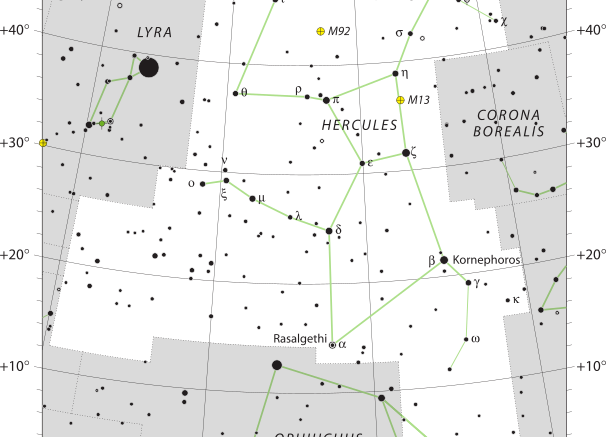Named after Hercules, the constellation Hercules was 1 of 48 constellations listed by astronomer Ptolemy in the 2nd century. Hercules was the Roman mythological hero adapted from the Greek hero Heracles. It is the 5th-largest of the modern constellations and is the largest of the 50 which have no stars brighter than apparent magnitude +2.5.
The constellation covers 1225.1 square degrees, which is 2.970% of the night sky.
| Applicable Information | |
| Visibility In Pacific Northwest | March To November |
| Best Times To View | July |
| Right Ascension | 17h |
| Declination | +30° |
| Area | 1225 square degrees |
| Main Stars | 14, 22 |
| Brightest Object | β Her — Kornephoros |
| Meteor showers | Tau Herculids |
| Messier objects | 2 |
| Neighboring Constellations | Draco, Boötes, Corona Borealis, Serpens Caput, Ophiuchus, Aquila, Sagitta, Vulpecula, Lyra |
The Name
It was named after Hercules, the Roman version of the Greek hero Heracles.
Heracles, in turn, was often associated with the Sumerian hero Gilgamesh, and the constellation itself has a long history, dating back to Sumerian times.
In mythology, the constellation Hercules is usually associated with the penultimate labour of Heracles, which involved killing the dragon Ladon, who guarded the garden of the Hesperides. The dragon is represented by the constellation Draco. Hercules constellation was first catalogued by the Greek astronomer Ptolemy in the 2nd century.
Stars
The constellation contains 11 formally named stars. Hercules hosts further quite bright double stars and binary stars. Kappa Herculis is a double star divisible in small amateur telescopes. The primary is a yellow giant with the secondary is being orange giant. Rho Herculis is a binary star that is also visible in small amateur telescopes.
Extrasolar planets are known to exist around 15 stars in Hercules.
M13, visible to both the naked eye and binoculars, is a globular cluster of the 6th magnitude is the brightest globular cluster in the northern hemisphere. It is so large that it is roughly half the size of the full moon, as individual stars in M13 are resolvable in a small amateur telescope.
M92 is a globular cluster that it is quite concentrated at the center with a very clear nucleus. Using binoculars, M92 is visible as a fuzzy star, like M13, but M92 is denser and smaller than M13. M92 is the oldest globular cluster known at this time and its stars are resolvable in a medium-aperture amateur telescope.
NGC 6229 is a dimmer globular cluster with a fairly rich in the center and is concentrated at the nucleus.
NGC 6210 is a planetary nebula is visible as a blue-green elliptical disk in amateur telescopes larger than 75 mm in aperture.
The Hercules–Corona Borealis Great Wall is the largest structure in the universe.
Make sure to check out other articles on the site, including a brief introduction to constellations, other constellation articles, and more!

Be the first to comment on "Hercules"